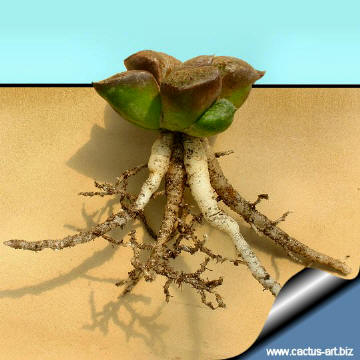|

Contractile roots of
Haworthia emelyae v. comptoniana
pull the plant deeper into the
soil to protect the plant from
sun and
heat during the
dry season. |
Contractile roots are
found in many plants species mainly at the
base of an
underground
organ (bulb,
corm,
succulent rosette, etc.)
The contractile roots continually pull the plants deeper into
the
ground as the stem
elongates so the it remain
subterranean or at an appropriate level in the ground..
Contractile roots are usually broad,
fleshy, vertical, tapering,
wrinkled looking and very distinct of the rather
cylindrical
fine absorbent roots and are capable of incredible effort.
In most cases, contractile roots not only produce a strong
pulling force on but also push away the
substratum and create a
soil channel in which plant movement is made easier. For example
in Haworthia the
fleshy contractile roots swell with
moisture in
the wet season creating a space in the
substrate then - after
the full drying out of
soil during the
dry season - a
considerable parts of this roots die off leaving empty spaces in
the substratum that allow plant movement with minimum or no
resistance, at the same time the other roots
dehydrates and shrinks
vertically, drawing the plant down into the ground. This is
repeated early permitting the top of the plant to remain
constantly at the soil level. |